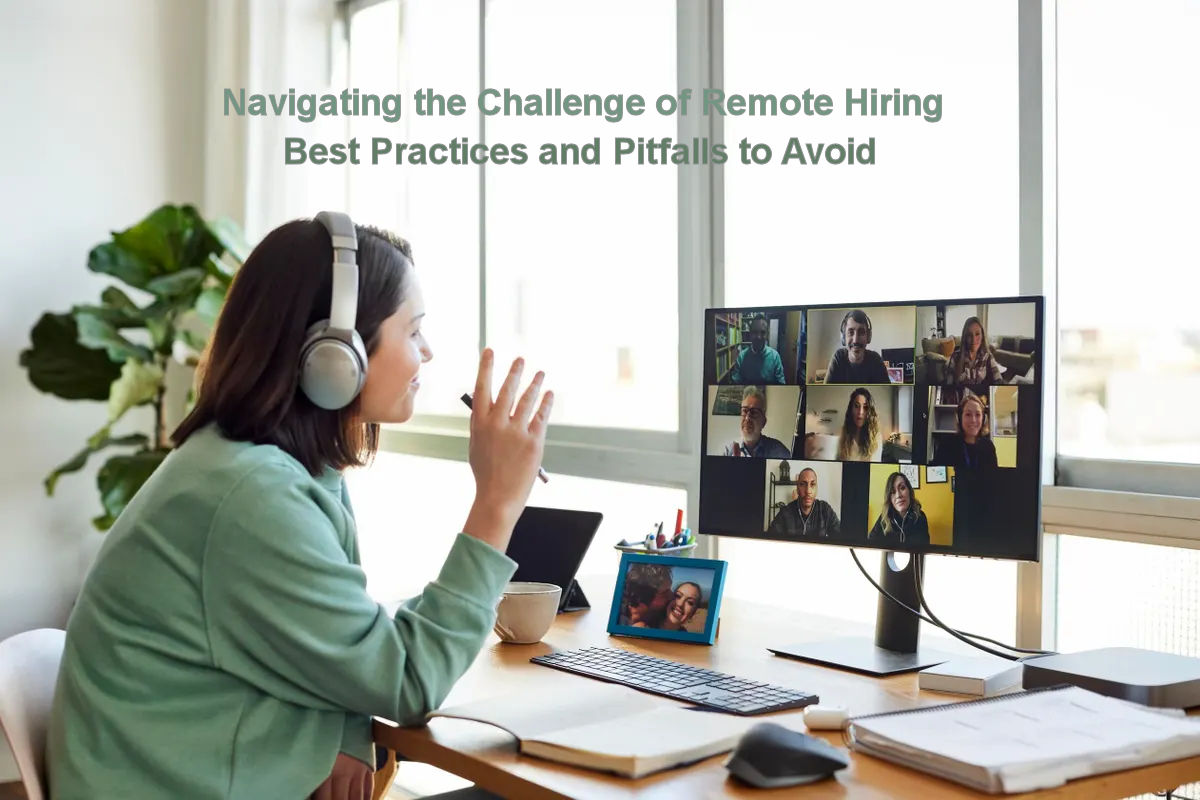In an era characterized by digital transformation and global connectivity, the landscape of recruitment and hiring has undergone a significant paradigm shift. Remote work has emerged as a powerful trend, offering unprecedented flexibility and access to a broader talent pool.
As a result, remote hiring has become a critical aspect of organizational growth and success. However, this shift brings its own set of challenges and pitfalls that must be navigated adeptly.
In this article, we will discuss the best practices to navigate the remote hiring process successfully and highlight some common pitfalls that organizations should avoid.
Embracing Remote Hiring: The Advantages and Opportunities:
Remote hiring, often referred to as virtual hiring or telecommuting, has gained momentum for various reasons, including:

-
Access to a Global Talent Pool:
Remote hiring breaks down geographical barriers, allowing organizations to tap into a diverse talent pool regardless of location. This enables businesses to access specialized skills that may not be readily available locally.
-
Enhanced Flexibility:
Remote work offers employees the flexibility to create a work environment that suits their needs, leading to improved work-life balance and potentially higher job satisfaction.
-
Cost Savings:
Remote hiring can result in substantial cost savings for both employers and employees. Organizations can cut down on overhead costs associated with office spaces, while employees save on commuting expenses.
-
Increased Productivity:
Many remote workers report increased productivity due to reduced distractions and a personalized work environment. This can lead to better outcomes and improved efficiency.
Best Practices for Remote Hiring:
As organizations embrace remote hiring, it’s crucial to implement best practices that ensure a seamless and effective recruitment process. Here are some strategies to consider:
-
Redefine Job Descriptions and expectations:
Remote hiring requires careful consideration of the specific skills, qualifications, and experience needed for a role. Clearly define the job requirements before beginning the hiring process to attract the right candidates.
Establishing performance metrics and expectations will help both the employer and the potential employee understand what is required to succeed in a remote work environment.
Craft clear and comprehensive job descriptions that explicitly outline the responsibilities and expectations for remote roles. Highlight essential skills such as self-motivation, time management, and effective communication, which are vital for remote work success.

-
Leverage video interviews and assessments:
Video interviews are now the go-to method for remote hiring. Prepare a list of structured questions to assess candidates’ skills and qualifications effectively.
Additionally, consider incorporating remote assessments or tests specific to the job role to gauge a candidate’s abilities accurately. Ensure that both interviewers and candidates have a stable internet connection to prevent any disruptions during the process.
Utilize applicant tracking systems to streamline the hiring process. Conduct virtual interviews to assess a candidate’s suitability for remote work and evaluate their digital communication skills.
-
Utilize collaborative hiring tools:
Collaborative hiring tools can streamline the remote hiring process, enabling efficient communication and collaboration among hiring managers, interviewers, and HR personnel. Tools like Trello, Slack, or Google Workspace facilitate seamless coordination, making it easier to evaluate candidates collectively and maintain a transparent hiring process.
-
Assess Soft Skills:
In addition to technical competencies, place a strong emphasis on assessing soft skills such as adaptability, collaboration, and self-discipline. Remote work demands a high level of autonomy, making these qualities essential for success.
Evaluate a candidate’s capacity to work effectively in a remote environment by assessing their remote work skills. Ask about their experience with remote collaboration tools, time management skills, and ability to communicate and meet deadlines while working remotely. This step is crucial to understand whether the candidate is adaptable and capable of thriving in a remote work culture.
-
Establish a strong employer brand:
Remote hiring makes it essential for organizations to build a strong online presence and employer brand. Showcase your company’s remote work culture, employee testimonials, and any flexible work policies to attract top talent.
Highlighting the benefits of remote work, such as work-life balance and increased productivity, can differentiate your organization from others and attract top remote candidates.

-
Remote Onboarding:
Design a comprehensive remote onboarding process that familiarizes new hires with the company culture, tools, and workflows. Provide adequate training and support to facilitate a smooth transition into the remote work environment.
-
Performance Metrics:
Define key performance indicators (KPIs) for remote roles and establish a system for measuring performance. Regularly review and provide feedback to ensure remote employees remain aligned with organizational goals.
-
Cultural Fit:
Evaluate a candidate’s alignment with the company’s values and culture, even in a remote context. A strong cultural fit contributes to higher job satisfaction, engagement, and long-term commitment.
Now, let’s take a look at some pitfalls to avoid when navigating remote hiring:
While remote hiring offers numerous benefits, it also presents certain challenges and pitfalls that organizations must be cautious of:
-
Failing to provide a detailed job description:
Avoid ambiguity when crafting a job description for remote positions. Clearly outline the required skills, experience, and remote work expectations to attract suitable candidates. By providing a thorough job description, you prevent confusion and increase the chances of finding the right match.
-
Neglecting Communication:
In a remote setup, clear and consistent communication becomes even more crucial. Failing to establish effective communication channels can lead to misunderstandings, decreased productivity, and isolation among remote employees.
Maintaining regular communication and offering feedback is vital for remote team members. Ensure there are channels for ongoing communication and feedback between managers and remote employees. Regular check-ins, virtual team meetings, and project updates can help address any challenges or concerns promptly.
-
Overlooking Loneliness and Isolation:
Remote workers may experience feelings of loneliness and isolation due to limited social interaction. It’s important to implement strategies to foster a sense of belonging and connection within the remote team.
-
Micromanagement:
Micromanaging remote employees can erode trust and hinder their autonomy. Focus on outcomes and results rather than constantly monitoring their activities.
-
Inadequate Onboarding and training:
Insufficient onboarding for remote hires can lead to confusion, decreased morale, and subpar performance. A well-structured onboarding process is essential for helping new hires integrate smoothly into the remote work environment.
Remote hires often face unique challenges when joining a new organization. Provide a comprehensive onboarding and training program to help them integrate smoothly into the remote work culture and understand their role fully. Engage with new hires regularly, set clear expectations, and provide them with the necessary tools and resources to excel in their position.
-
Lack of Performance Tracking:
Without proper performance tracking and accountability measures, it’s challenging to ensure that remote employees are meeting their goals and contributing effectively. Implement a system for monitoring progress and offering constructive feedback.
-
Time Zone and Cultural Differences:
Global remote teams often span different time zones and cultures. Failing to address these differences can lead to scheduling conflicts, reduced collaboration, and misalignment of priorities.
Conclusion:
Remote hiring is a dynamic and transformative approach to recruitment that offers both opportunities and challenges. By adopting best practices such as redefining job descriptions, utilizing video interviews, and emphasizing soft skills, organizations can successfully navigate the remote hiring landscape.
However, it’s essential to remain vigilant and avoid pitfalls such as failing to provide detailed job descriptions, communication gaps, isolation, and micromanagement. With a strategic and holistic approach, businesses can harness the benefits of remote hiring while mitigating potential risks, ultimately fostering a thriving and engaged remote workforce.




